
Fish, Ubirr rock art site
[ < < previous | index | next >> ]
Let me tell you about the dirt. Our clothes are dirty. We are dirty. Our shoes are dirty. All with the insidious red dust of the Australian Outback. It's a tired, old, worn-down country. You can see the age and the weariness in the vast landscapes of eroded sandstone. It's all flat, weathered, tumbled sedimentary rock. Rock that has been pounded, crushed, laid up in drifts of sand, compressed by aeons, pushed around, cracked, uplifted, tilted, exposed to the harshness of the sun, the wind, the rain, until it gives up - it just throws its metaphorical arms in the air and says, "You win," as it crumbles away again, leaving behind cracked, fractured, bent, beaten, stained, sculpted, and abused over and over again rock that lays on the landscape like someone who doesn't have the energy to get up after a hard, long life of toil and sweat and grime.
This rock is the foundation of Australia, underneath the red earth, forming the red dust as it slowly but inexorably grinds away leaving just a few hills and cliffs behind - no mountains, no majestic snow-capped peaks of sharp granite or basalt or gneiss. This is all old-stone country. The igneous rocks have all long been broken down into tiny grains, pulped, layered, compressed, and turned into sediment, then rock again only to be eroded away once more. This land is old. You can see it in the landscape. The more you see it, the more you feel it - the weight of hundreds of millions of years.
And the result of all that erosion is red dirt. Fine red dirt, like dust, that gets everywhere. In your clothes, socks, and shoes. On your skin. When we come back to our room from a day out walking around - here at Kakadu, further south at Uluru, or in between, anywhere else we've been - we look like we've received instant tans. A quick wipe turns the skin two shades lighter and leaves the stain of the red dirt on the towel. But it doesn't come out of the clothes. Our white socks, despite two laundry cycles, are now reddy-brown. Our shoes are reddy-brown. When we put on clean white socks, then put the shoes on, then take the shoes off, the socks are reddy-brown.
Today was (hopefully) the last of the accumulation of more of the Australian landscape on our clothes. Tomorrow we head to Darwin and city living. Today however, we hit Kakadu one last time.
We slept in and had a lazy breakfast. The plan was to spend the morning doing laundry and resting, then head out for an afternoon of activity. We put our incredibly dirty clothes into the Crocodile Inn guest laundry. The intention was to get the sweat out and distribute the red dirt a bit more evenly, which seemed to work as planned. While the clothes were busy getting more uniformly dirty, we took a stroll over to the Kakadu Bakery, just across the road and behind the fire station. It had a mouth-watering selection of fresh savoury and sweet baked goods. M. bought a herb scroll for lunch and I grabbed a chocolate and cherry muffin for a post-breakfast snack. it was delicious, with plump juicy cherries. We decided to go back tomorrow to grab lunch on the way out of Jabiru.
On the way back from the bakery, we saw a group of six straw-necked ibis on the hotel grounds. That brings us up to all three species of ibis that we've seen here in the past few days. Other than that, we basically relaxed all morning.
 Fish, Ubirr rock art site |
At 12:00 we headed out to drive the 40 km or so to Ubirr, where there is another famous rock art site. We did the short loop walk to see the art. It was good, but not as surprisingly amazing as yesterday at Nourlangie. The day was hot and slowly clouding over, but the sun was mostly still getting through the gaps. That, combined with our relative exhaustion from the holiday so far, made it heavy going.
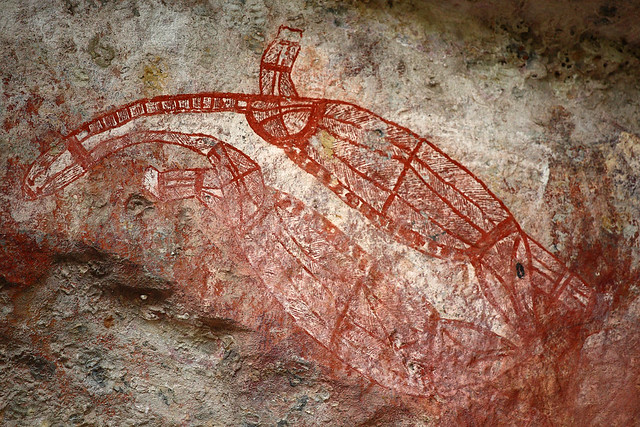 X-ray art, Ubirr rock art site |
At one of the art sites we wandered in on a park ranger giving a free talk about the rock art. The particular piece was an illustration of a legend about an ancestral being who fished for barramundi and caught five of the fish before resting. There was something about a fight with someone else and the result was a traditional law stating that you should never take more than five barramundi at once. This native law has found itself expressed in the Northern Territory fishing laws, wish also specify a bag limit of five barramundi for modern day anglers.
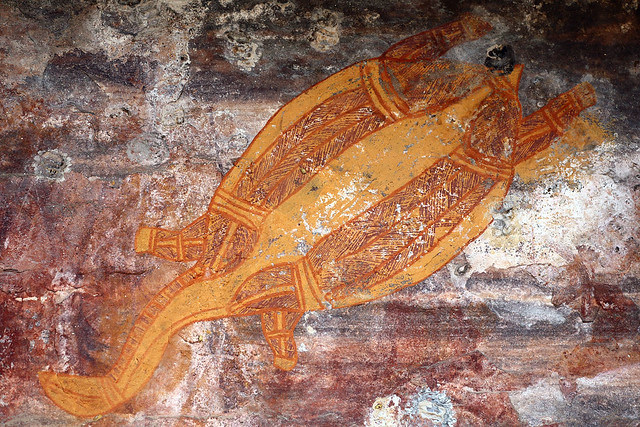 Turtle, Ubirr rock art site |
On the way back to the car, we spotted a small wallaby resting in between two flat rocks, that formed a V-shaped pocket tipped over sideways so one arm of the V formed a platform and the other a roof. It was in deep shadow and silhouetted against the sky behind. The ranger behind us said it was a short-eared rock wallaby. Well spotted, us!
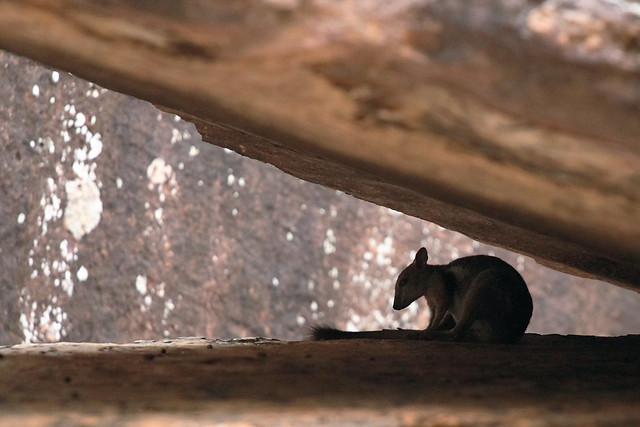 Short-eared rock wallaby, Ubirr rock art site |
Once done, we retreated to a shaded table outside the East Alligator Border Store, to sit in the relative cool and rest a bit. The Border Store was a rather run-down and eclectic small general store, without air conditioning of any sort, other than screened windows to let any breeze (of which there was none) through.
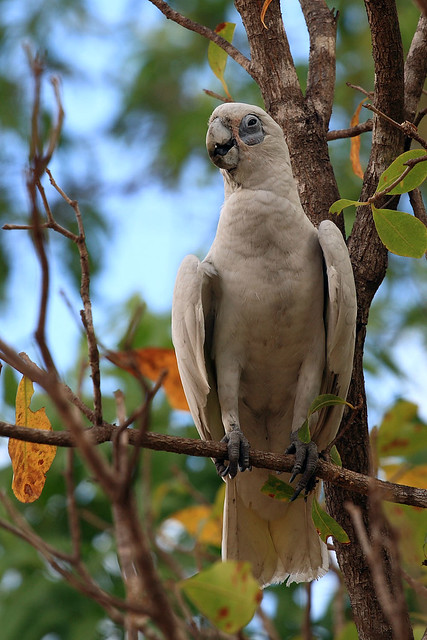 Little corella, near Cahill's Crossing, East Alligator River |
We had to be at the upstream boat ramp on the river by 14:45 for our 15:00 river cruise on the East Alligator River. We parked the car near Cahill's Crossing, a ford across the river that led into Arnhem Land - the last frontier of Australian wilderness and remoteness. From there we walked to the boat ramp and waited on some shady seats for the cruise. While waiting, two women, presumably a mother and daughter - who had been on our Katherine River cruise - showed up for the same cruise! They spoke some Eastern European language, but acknowledged us with a nod and smile.
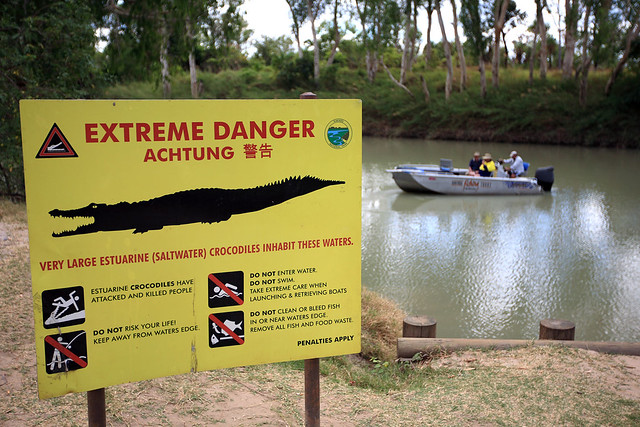 Near Cahill's Crossing, East Alligator River |
The previous cruise returned and unloaded, and the Aboriginal guides checked our tickets and ushered us on board. A large tour group showed up and took one boat, crewed by two women, while all of us separate tourists took a separate boat, crewed by a guy who claimed his name was Roman, but who was clearly a very well-tanned Elvis, incognito in mirrored sunglasses.
He took us out on to the East Alligator River, where we saw several saltwater crocodiles sunning themselves on the banks. There was one every 20 or so metres along the river, of various sizes, from a 4.2 metre male that Elvis knew as "Tom" by a missing tail spine, to a ~1 m long juvenile that Elvis estimated to be 18 months old.
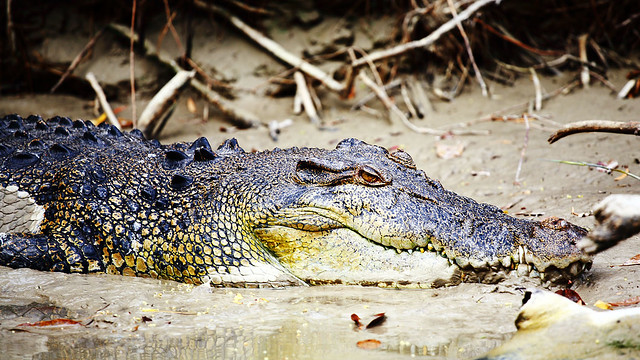 Saltwater crocodile, East Alligator River |
The cruise up the river was rather slow and stately, with stops in several places for Elvis to discuss native uses of the various trees growing on the river banks. I was hoping the cruise would take us far enough up-river to the see the Arnhem Escarpment, where it flanked the eastern bank. But when we progressed some way, Elvis told us that Cyclone George 18 months ago had completely changed the river landscape, destroying a large patch of the forest and washing millions of tonnes of sand downstream to form a sort of sandy desert not too far from the boat ramp. As we drove up-river, we began to see the devastation wrought by George, with massive trees uprooted and fallen on both sides of the river, and then a choking morass of sand reducing the river to a shallow net of rivulets running over wide sandbars, and to the eastern side an empty expanse of sand rolling away in dunes to where the forest finally reappeared in the distance. It was obvious the boats could go no further, and both ours and the tour group's pulled up at the sandy bank to let everyone of. As we disembarked, Elvis invited us to fill our shoes with sand, our socks with sand, our pockets with sand - "Take it away!" he said, they didn't want it.
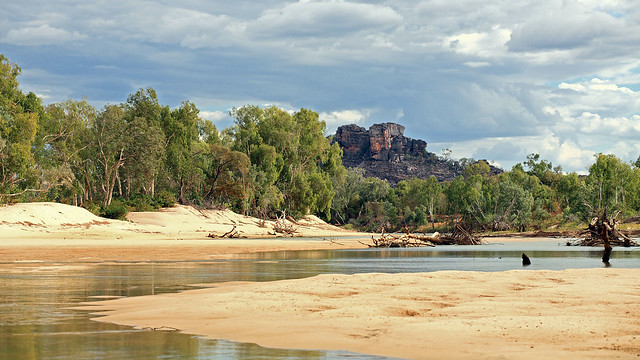 East Alligator River; sand flats left by Cyclone George |
On the sand, the women tour guides gave us a talk about women's traditional tools, showing us a digging stick and some woven baskets. They said that men made the digging stick and gave it to the women to use. Once the women had the made stick, it became "women's business", and no man was allowed to touch it, on pain of punishment from the women. Similarly, women wove dilly bags for the men to store hunting tools and captured game, and once handed over to the men they became taboo for the women. Then when they finished talking about the women's tools they said Elvis would talk to us about spears, since they were men's tools and they weren't allowed to talk about them.
Elvis gave us a lecture on spear-making and a demonstration of a few different specialised types of spear - fishing spear, goose-hunting spear, big game spear - all different and made using different materials and with different methods. He also gave us a graphic description of traditional native punishments involving spearing in various parts of the body, and how these punishments in indigenous communities are still carried out today with the approval of Northern Territory law.
The talks done, we headed back down-river. While relaunching our boat we saw an angler approach the sandbars in a small fishing boat, get out into the shin-deep water, and start pushing the boat over the bar. One of the tourists in our group asked, "Isn't that dangerous with the crocs?" and Elvis said, "Yep, I wouldn't be in that water." But he said there was nothing he could say to people like that and let the guy risk his own life by continuing on. On the way back we saw both lesser and intermediate egrets on the river banks. No crocs got the angler, that we saw anyway.
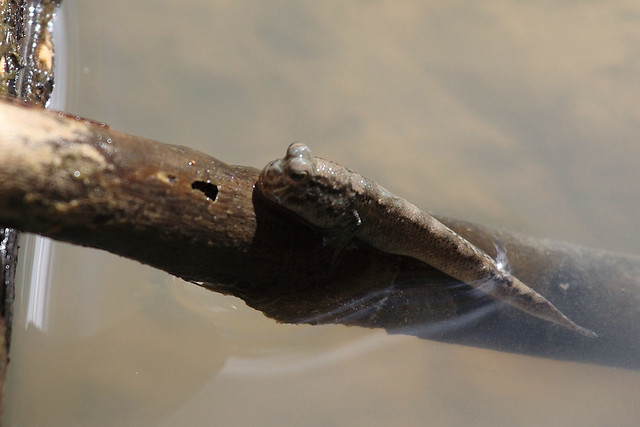 Mudskipper, East Alligator River |
Once off the cruise, we walked back to the car. We were stopped at one point by a loud rustling coming from the woods near the path. Peering into the undergrowth, we spotted a large bird scratching around in it. We later checked our bird book and identified it as an orange-footed scrubfowl. Amazing sight, and an impressively sized bird.
We headed back to the Border Store to rest in the shade a bit more. The cloud had built up during the day again, but not to an overcast level as the past two days, and it was still beating down hard and hot in between the fluffy white clouds.
 Sunset from Ubirr Rock, looking over Nadab floodplain |
At 17:30 we headed out to Ubirr rock again, this time to climb the rock up to the lookout over the Nadab Floodplain to the west. There was more rock art to inspect along the way. Then we reached a flat viewing area where a park ranger was giving a talk to an audience of thirty or so people. More arrived behind us, and some had gone further to climb right to the very top of the rock - up an additional steep section of shattered sandstone.
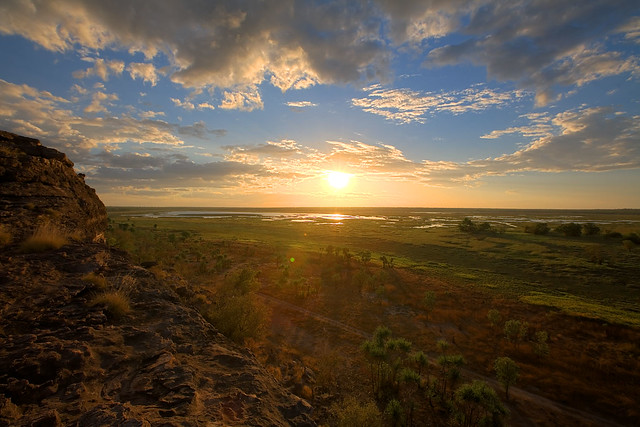 Sunset from Ubirr Rock, looking over Nadab floodplain |
The view from the flat area, however, was good enough - a spectacular panorama across a plain dotted with trees that shrank into the distance, with ribbons of water reflecting the patterns of the sun and clouds in the sky, and flights of birds wheeling away in the distance and squawking and chattering closer to the rock. With the sky beautifully textured it was a sight to behold. And we were here to see the sunset, so it just got better as the minutes ticked by.
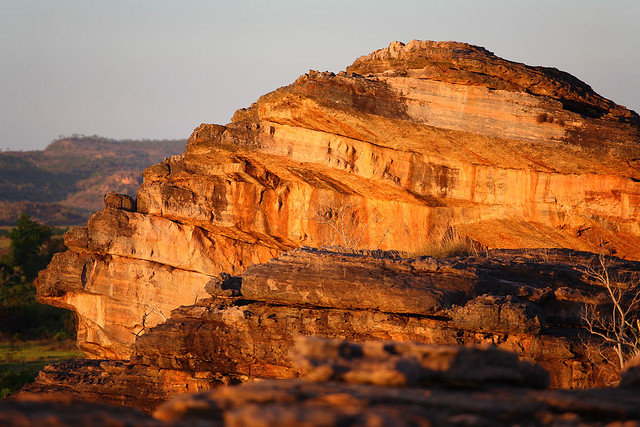 Ubirr Rock, in evening light |
As the sun dropped, the landscape glowed and the rock around us lit up red against the sky. Pink and orange and purple streaked the clouds and the sun flushed a deep crimson as it sank to the horizon, all reflected in the luminous threads of water running across the floodplain. There were upwards of a hundred people on the rock to witness this feast of nature, and the sounds of gasping, exclamations of incredibleness, and the clicking of camera shutters accompanied the show. Despite the crowd, which was dispersed widely enough across the rock not to be too distracting, it was simply a stunning and glorious experience.
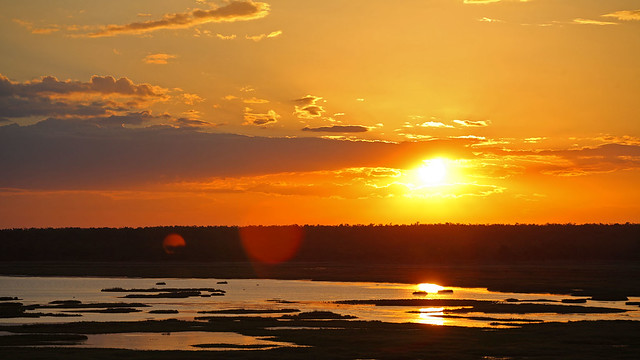 Sunset from Ubirr Rock, looking over Nadab floodplain |
Soon after the sun vanished, the park ranger started herding people off the rock and back to the car park because the Ubirr region is closed to the public after dark. We lingered towards the last few people to capture more of the colour left in the sky, and then moved on with an older woman who turned out to be from Mona Vale in Sydney. We exchanged traveller's tales as we walked back to the car - she telling us about her past three years of almost constant travel around Australia. Once back to the car, we drove back to Jabiru in the middle of a convoy of three cars heading through the deepening gloom. At one point our cars were overtaken by an insane idiot who pulled out to overtake on a blind corner, with the road line indicating no overtaking. The fool was lucky not to intersect an oncoming vehicle.
 Sunset from Ubirr Rock, looking over Nadab floodplain |
Back at the Crocodile Inn at Jabiru, we went to the buffer dinner again, there being little other decent option in town. M. stocked up on veges again, then had fruit salad and cheese and crackers. I started with the soup, which was cream of mushroom today, then moved on to a plate of prawns. The main dishes were different today, with kangaroo in pepper sauce replacing the steak, the crocodile done in a Thai curry sauce, the chicken done cajun style, and the barramundi in a slightly different sauce. I had a piece of roo and chicken, and some barra again. Then it was on to the desserts. I went a bit easier than yesterday, but not too much easier! There was no black forest cake today for starters.
But the most amazing thing at dinner was that we were seated at a table next to Ned Flanders from The Simpsons. I pointed the guy out to M. - he had the glasses, moustache, yellow hair - and she agreed it was definitely him.
After dinner, it was time for sleep.
[ < < previous | index | next >> ]